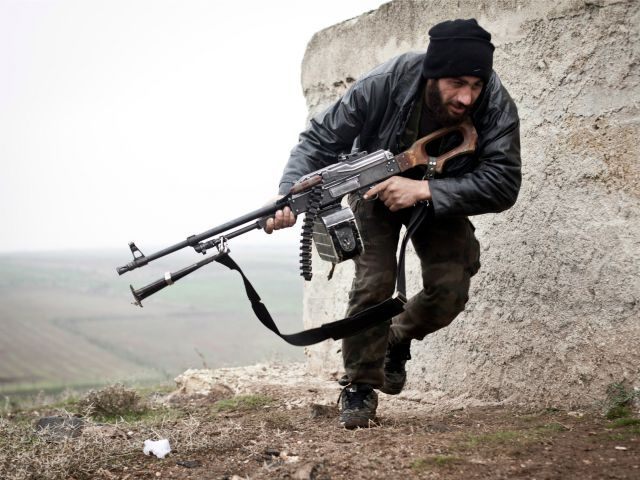President Barack Obama’s Central Intelligence Agency and its allies in the region have crafted a plan to provide more-powerful weapons to so-called moderate Syrian rebels combating the Russia-backed Bashar al-Assad regime in case the ongoing fragile ceasefire fails, the Wall Street Journal (WSJ) has learned.
Citing unnamed U.S. and other officials, WSJ notes, “The preparations for a so-called Plan B center on providing vetted rebel units with weapons systems that would help them in directing attacks against Syrian regime aircraft and artillery positions.”
In February, the Journal revealed that Obama’s top military and intelligence advisers were urging the White House to prepare Plan B to counter Russia’s intervention on behalf of Assad in Syria.
“Since then, fresh details have emerged on the nature of the new weaponry that could be deployed under the covert program,” reports WSJ. “The preparations were discussed at a secret meeting of spy chiefs in the Middle East just before the cease-fire took effect on Feb. 27 and in follow-on exchanges between intelligence services.”
“Negotiations are set to resume in Geneva on Wednesday as the ceasefire in Syria comes under increasing strain and the government of President Bashar al-Assad holds parliamentary elections in areas under its control,” it adds.
The CIA has assured U.S.-led coalition members that they would be granted permission to increase support to moderate Syrian rebels, according to officials familiar with the Geneva meetings.
“Coalition members have agreed on the outlines of Plan B, but the White House must still approve the list of specific Plan B weapons systems before they can be introduced to the battlefield,” reports WSJ.
“Officials said the CIA has made clear to its allies that the new systems, once agreed upon, would be given to the rebels only if the truce and the concurrent political track toward a lasting peace—Plan A—fall apart and full-scale fighting resumes,” it continues.
The Journal acknowledges that the CIA has declined to comment on the alleged deliberations.
“The agreement is to up the ante, if needed,” a senior U.S. official told WSJ, referring to the CIA’s message to the coalition in support of the Syrian opposition, adding that the Obama administration’s primary goal now was to find ways to make the truce and political negotiations stick.
This week, representatives from the Assad regime and the opposition are expected to resume United Nations-brokered negotiations to end the brutal civil war in Syria, which has been raging since March 2011.
In private, U.S. officials have reportedly conveyed to Russia, which has been providing military support to Assad since the end of September 2015, “that the moderate opposition isn’t going away and that a return to full-scale fighting could end up putting more Russian pilots in danger.”
“Development of the weapons list is part of a broader behind-the-scenes effort by the Obama administration to deter its adversaries in the Syrian conflict while preventing the U.S.’ coalition partners who are supporting the moderate opposition from taking matters into their own hands,” points out WSJ.
It adds:
The agency’s principal concern focuses on man-portable air-defense systems, known as Manpads. The CIA believes that rebels have obtained a small number of Manpads through illicit channels. Fearing these systems could fall into terrorists’ hands for use against civilian aircraft, the spy agency’s goal now is to prevent more of them from slipping uncontrollably into the war zone, according to U.S. and intelligence officials in the region.
Coalition partners have proposed ways to mitigate the risk. They have suggested tinkering with the Manpads to limit how long their batteries would last or installing geographical sensors on the systems that would prevent them from being fired outside designated areas of Syria. But Washington has remained cool to the idea.
The CIA’s covert program to train and supply moderate Syrian rebels has gradually expanded since it was implemented in 2013.
So-called moderate Syrians have been provided “limited supplies of small arms and ammunition,” reports the Journal.
“In 2014, the CIA introduced advanced antitank TOW missiles on the battlefield, helping the rebels gain ground on the regime, until Russia’s intervention last year drove the fighters back,” it adds.
U.S. Secretary of State John Kerry has emphasized the value the Obama administration has placed on ensuring the ceasefire maintains.
WSJ notes:
The cease-fire, which has held far longer than officials in Washington and in the region had expected, has reduced the overall level of violence in Syria and brought about a pause in the proxy fight between Russia and the U.S. on the Syrian battlefield, buying time for the former Cold War adversaries to consider their next steps there and, in some cases, work together.

COMMENTS
Please let us know if you're having issues with commenting.